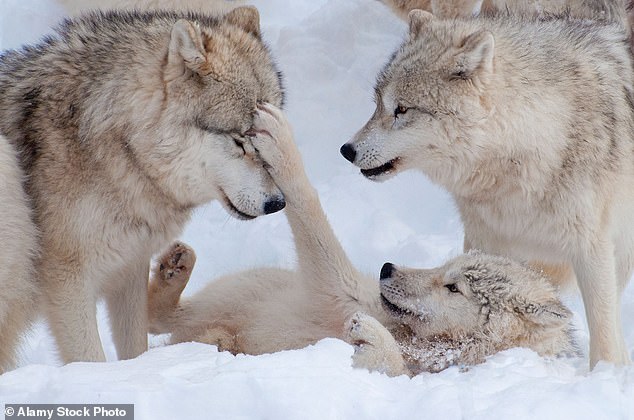Dogs were bred to wag their tails because HUMANS enjoy the rhythm of the movement, scientists claim
If you’ve ever wondered why seeing a wagging dog makes you so happy, science may have an answer.
People’s relationship with puppies dates back to the dawn of civilization, but it has never been known why they wag their tails more than other dogs.
Scientists at the Max Planck Institute for Psycholinguistics now say the real reason is that people enjoy the rhythm of movement.
In an op-ed, the researchers suggest that early humans may have subconsciously selected dogs that wagged their tails more rhythmically.
However, they note that this is just one theory and that this behavior could also be a byproduct of dogs becoming friendlier.
Researchers suggest that early humans may have subconsciously selected dogs that wagged their tails more rhythmically (stock image)
Despite how much joy both dogs and humans seem to get from wagging behavior, little research has been done on how this behavior evolved.
Undomesticated canines such as wolves do wag their tails as a form of communication, but not nearly as much as dogs.
Wagging the tail also seems to be something that dogs do naturally and not something they are taught.
In human-raised wolf and dog pups, the difference emerges when they are just three weeks old, with dog pups wagging their tails much more often.
According to the scientists, this suggests that tail wagging is a side effect of domestication or a conscious choice by humans.
One theory, which the authors call “domesticated rhythmic wagging,” suggests that humans selectively bred dogs that wagged their tails more frequently and rhythmically.

Compared to other canines, like these Arctic wolves, dogs wag their tails a lot more – and the differences emerge while both wolves and dogs are just three weeks old (stock image)
The scientists write: ‘Humans have remarkable abilities to perceive and produce rhythmic sequences, especially isochronous patterns in which events are evenly spaced in time.’
Furthermore, cognitive neuroscience has shown that human brains actually prefer rhythmic stimuli, such as the swishing of a dog’s tail.
The researchers say these rhythms “elicit pleasurable responses and engage brain networks that are part of the reward system.”
Therefore, the scientists suggest that the preference for rhythmic patterns may have driven the choice of wagging tails in dogs.
Previous research has shown that dogs have impressive skills at communicating with people, even asking their owners for help with difficult tasks.
However, this is just one of the possible theories to explain dogs’ wagging tails.
The other, which the researchers call the “domestication syndrome” hypothesis, suggests that tail wagging could be a byproduct of breeding friendlier dogs.
The researchers point out that in a study of silver foxes that were bred for tameness and docility over 40 generations, the foxes wagged their tails more in later generations.
Although there was no selection for tail wagging, the friendlier foxes had curly tails and wagged more like dogs.
The researchers write: ‘Changes in wagging behavior could thus have arisen as a by-product of selection on some other trait, such as tameness or friendliness towards people.’
Both theories explain why some dog breeds wag their tails more than others.
‘Selection for wagging behavior may not have been uniform across breeds; For example, hunting dogs wag their tails more than herding dogs, and have also experienced different selective pressures during domestication,” they say.
However, the scientists say more experiments will be needed to determine the real reason why dogs wag their tails.
The opinion article was published in Biological letters.
